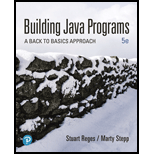
Concept explainers
Explanation of Solution
Recursion:
A technique where an
a)
Code:
//class definition
class Main
{
//method definition
public static void mystery2(int n)
{
//condition to validate the value of n
if (n >100)
{
//display the value of n
System.out.print(n) ;
}
//else part
else
{
//function call
mystery2(2*n) ;
//display the value
System...
Explanation of Solution
Recursion:
A technique where an algorithm is described in terms of itself is called as recursion.
b)
Code:
//class definition
class Main
{
//method definition
public static void mystery2(int n)
{
//condition to validate the value of n
if (n >100)
{
//display the value of n
System.out.print(n) ;
}
//else part
else
{
//function call
mystery2(2*n) ;
//display the value
System...
Explanation of Solution
c)
Code:
//class definition
class Main
{
//method definition
public static void mystery2(int n)
{
//condition to validate the value of n
if (n >100)
{
//display the value of n
System.out.print(n) ;
}
//else part
else
{
//function call
mystery2(2*n) ;
//display the value
System...
Explanation of Solution
d)
Code:
//class definition
class Main
{
//method definition
public static void mystery2(int n)
{
//condition to validate the value of n
if (n >100)
{
//display the value of n
System.out.print(n) ;
}
//else part
else
{
//function call
mystery2(2*n) ;
//display the value
System...
Explanation of Solution
e)
Code:
//class definition
class Main
{
//method definition
public static void mystery2(int n)
{
//condition to validate the value of n
if (n >100)
{
//display the value of n
System.out.print(n) ;
}
//else part
else
{
//function call
mystery2(2*n) ;
//display the value
System...
Want to see the full answer?
Check out a sample textbook solution
Chapter 12 Solutions
MyProgrammingLab with Pearson eText -- Access Code Card -- for Building Java Programs
- Please solve and answer the questions correctly please. Thank you!!arrow_forwardConsidering the TM example of binary sum ( see attached)do the step-by-step of execution for the binary numbers 1101 and 11. Feel free to use the Formal Language Editor Tool to execute it; Write it down the current state of the tape (including the head position) and indicate the current state of the TM at each step.arrow_forwardI need help on inculding additonal code where I can can do the opposite code of MatLab, where the function of t that I enter becomes the result of F(t), in other words, turning the time-domain f(t) into the frequency-domain function F(s):arrow_forward
 Database System ConceptsComputer ScienceISBN:9780078022159Author:Abraham Silberschatz Professor, Henry F. Korth, S. SudarshanPublisher:McGraw-Hill Education
Database System ConceptsComputer ScienceISBN:9780078022159Author:Abraham Silberschatz Professor, Henry F. Korth, S. SudarshanPublisher:McGraw-Hill Education Starting Out with Python (4th Edition)Computer ScienceISBN:9780134444321Author:Tony GaddisPublisher:PEARSON
Starting Out with Python (4th Edition)Computer ScienceISBN:9780134444321Author:Tony GaddisPublisher:PEARSON Digital Fundamentals (11th Edition)Computer ScienceISBN:9780132737968Author:Thomas L. FloydPublisher:PEARSON
Digital Fundamentals (11th Edition)Computer ScienceISBN:9780132737968Author:Thomas L. FloydPublisher:PEARSON C How to Program (8th Edition)Computer ScienceISBN:9780133976892Author:Paul J. Deitel, Harvey DeitelPublisher:PEARSON
C How to Program (8th Edition)Computer ScienceISBN:9780133976892Author:Paul J. Deitel, Harvey DeitelPublisher:PEARSON Database Systems: Design, Implementation, & Manag...Computer ScienceISBN:9781337627900Author:Carlos Coronel, Steven MorrisPublisher:Cengage Learning
Database Systems: Design, Implementation, & Manag...Computer ScienceISBN:9781337627900Author:Carlos Coronel, Steven MorrisPublisher:Cengage Learning Programmable Logic ControllersComputer ScienceISBN:9780073373843Author:Frank D. PetruzellaPublisher:McGraw-Hill Education
Programmable Logic ControllersComputer ScienceISBN:9780073373843Author:Frank D. PetruzellaPublisher:McGraw-Hill Education





